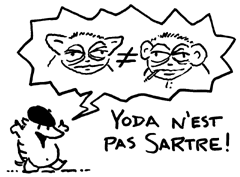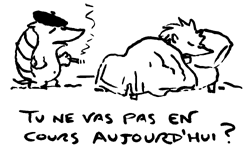Module 02: Me voici!
Première Partie: L’Identité / Les questions personnelles; Explication de grammaire
In this section:
- Le verbe avoir – to have
- Forming Questions
- Basic Negation
- La nationalité
Le verbe avoir
The verb avoir is irregular in the present tense. Listen carefully to the pronunciation of the –s in the plural pronouns nous, vous, and ils/elles/iels. This -s is pronounced as a /z/ to link with the vowel sound in the plural forms of avoir. This liaison, or linking, is especially important in distinguishing ils ont (they have) from the third person plural of être ils sont (they are).
| avoir ‘to have’ | |
| j’ai | nous avons |
| tu as | vous avez |
| il/elle/iel/on a | ils/elles / iels ont |
| past participle: eu | |
Avoir is also used as an auxiliary in compound tenses (passé composé with avoir, plus-que-parfait, futur antérieur, etc.) Besides ownership, the verb avoir expresses age in French, unlike the English equivalent, which uses the verb ‘to be.’
| Alex: Sam, tu as des frères et des soeurs? | Alex: Sam, do you have brothers and sisters? | |
| Sam: Oui, j’ai une soeur et un frère. | Sam: Yes, I have a sister and a brother. | |
| Alex: Quel âge ont-ils? | Alex: How old are they? | |
| Sam: Ma soeur Rita a 30 ans et mon frère Trey a 16 ans. | Sam: My sister Rita is 30 and my brother Trey is 16. |
Forming Questions

| 1. | questions with intonation | |
| 2. | questions using ‘est-ce que…?’ | |
| 3. | questions using ‘n’est-ce pas?’ |
![]()
questions with intonation
One of the easiest ways to ask a question that may be answered by yes/no is to raise the pitch of your voice at the end of a statement. In a declarative statement, the pitch normally falls. Listen to the following dialogue and pay close attention to the intonation.
![]()
| Sam: Trey, tu aimes la philosophie? | Sam: Trey, do you like philosophy? | |
| Trey: Non. Je n’aime pas la philosophie. | Trey: No. I do not like philosophy. | |
| Sam: Tu connais Sartre? | Sam: Do you know Sartre? | |
| Trey: Non. Qui est-ce? | Trey: No. Who is that? | |
| Sam: Gloups! C’est l’auteur du chef d’oeuvre existentialiste, La Nausée. | Sam: Gulp! He’s the author of the existentialist masterpiece, Nausea. |
![]()
questions using ‘est-ce que … ?’
Another way to ask a yes/no question is to place est-ce que before a statement. Note that que becomes qu’ before a vowel.

| Trey: Et toi, Sam, est-ce que tu aimes les films? | Trey: And you, Sam, do you like movies? | |
| Sam: Bien sûr, j’adore les films. | Sam: Of course, I love movies. | |
| Trey: Est-ce que tu connais Yoda? | Trey: Do you know Yoda? | |
| Sam: Non. Qui est-ce? | Sam: No. Who is that? | |
| Trey: Duh … | Trey: Duh … |
![]()
questions using ‘n’est-ce pas ?’
N’est-ce pas? is added to the end of a yes/no question when the speaker expects an affirmative response.
![]()
| Trey: Tu connais ‘La guerre des étoiles,’ n’est-ce pas? Yoda, c’est le petit sage. | Trey: You know ‘Star Wars,’ don’t you? Yoda is the little wise man. |
![]()
Listen to the end of the dialogue:

| Trey: Yoda est mon héros. Tu ne connais pas Yoda? | Trey: Yoda is my hero. You don’t know Yoda? | |
| Sam: Ah, si, si, si*, je connais le petit philosophe. Est-ce que tu es fou? Yoda n’est pas Sartre. | Sam: Ah, yes, yes, yes, I do know the little philosopher. Are you crazy? Yoda is not Sartre. | |
| Trey: Oh, mais la philosophie de Yoda est plus intéressante que la philosophie existentialiste de La Nausée! Tu es d’accord, n’est-ce pas? | Trey: Oh, but Yoda’s philosophy is more interesting than the existentialist philosophy of La Nausée! You agree, don’t you? | |
| Sam: Quel crétin! Retourne à tes jeux électroniques! | Sam: What an idiot! Go back to your video games! |
*Si is used to answer ‘yes’ to a negative question.
Basic Negation

ne…pas
Basic negation is formed by placing ne … pas around the conjugated verb. Ne becomes n’ in front of a verb starting with a vowel or a mute h.
![]()

| Sam: Tu ne vas pas en cours aujourd’hui, Sacha? | Sam: You’re not going to class today Sacha? | |
| Sacha: Non. Je ne vais pas bien. Je ne peux pas manger et j’ai mal à la tête. | Sacha: No. I am not well. I cannot eat and I have a headache. | |
| Sam: Tu n‘as pas de chance! Ce soir, il y a une fête chez Eliott! | Sam: That’s too bad [literally ‘you are not lucky’]! Tonight there is a party at Eliott’s! | |
| Sacha: Tu n’es pas d’un grand réconfort, tu sais! | Sacha: You are not a lot of comfort, you know! |
![]()
In compound tenses, like the passé composé, the ne … pas are also placed around the conjugated verb, which is the auxiliary, avoir or être. In the periphrastic future, ne … pas goes around the verb aller.
![]()
| Sam n‘a pas été très gentil. | Sam was not very nice. | |
| Sacha ne va pas passer la soirée chez Eliott. | Sacha is not going to spend the evening at Eliott’s. |
Note that in spoken French, the ne / n’ is sometimes dropped. In familiar speech, tu is often pronounced as t’ before a vowel.
![]()
| Sacha: Sam, t’es (tu es) pas très gentil. | Sacha: Sam, you are not very nice. |
La nationalité
Each country (pays) and continent (continent) have an adjective to describe people and things from that country/continent. The adjective to describe nationality changes depending on whether the person is masculine (ex : américain) or feminine (ex : américaine).
If the person is non-binary, a middot may be used in writing (ex: americain·e) but, as mentioned previously, there is no agreed upon way of pronouncing a word with a middot. When speaking, consider changing the structure of the sentence: “Iel vient d’États-Unis.”
Note: In the French language, nationalities must be capitalized when used as nouns.
However, when they are used as adjectives, they do not need to be capitalized.
Exemple :
Mon copain est canadien – ici, canadien est l’adjectif.
Je connais une Québecoise qui a le même nom de famille que moi – ici, Québecoise est un nom (noun)
Here, you will learn some nationalities that have common masculine/feminine endings in French. Note the (e) (ne) represents people who identify as feminine or feminine objects.


